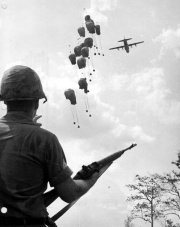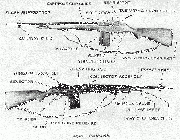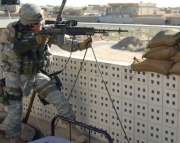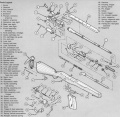M14 rifle
| |||||||||||||||||||||||||||||||||||||||||||||||||||||||||||
The M14 rifle, formally the United States Rifle, Caliber 7.62 mm, M14, is an American selective fire battle rifle firing 7.62x51mm NATO ammunition. Although largely superseded in military use by the M16 rifle, it remains in limited front line service with the United States Army, Marine Corps, and Navy. The M14 also provides the basis for the M21 and M25 sniper rifles.
Contents[hide] |
[edit] Development
The M14 was developed from a long line of experimental weapons based upon the M1 Garand. Although the Garand was one of the most advanced infantry rifles of the 1940s, it was not a perfect weapon. Modifications were beginning to be made to the basic M1 rifle's design since the twilight of the Second World War. Modifications included adding a fully automatic firing capability and replacing the 8-round "en bloc" clips with a detachable box magazine holding 20 rounds. Winchester, Remington, and Springfield Armory's own John Garand offered different conversion designs. Garand's design, the T20, was the most popular, and T20 prototypes served as the basis for a number of Springfield test rifles from 1945 through the early 1950s.
Earle Harvey of Springfield Armory designed a completely different rifle, the T25, for the new .30 Light Rifle cartridge. The latter was based upon .30-06 cartridge case cut down to the length of the .300 Savage case. The .30 Light Rifle eventually evolved into the 7.62x51mm NATO and the commercial .308 Winchester round. In the background, Lloyd Corbett was tasked with developing .30 Light Rifle conversions for the M1 rifle and later the T20 prototypes. After a series of prototype designs, the T44 surfaced. The earliest T44 prototypes used the T20 receivers rebarreled for 7.62 mm NATO, and replaced the long operating rod/piston of the M1 with the T25's shorter "gas expansion and cut-off" system. Later T44 prototypes used newly fabricated receivers shorter than either the M1 or T20; the new action's length was matched to the shorter 7.62 mm NATO cartridge instead of the longer .30-06. The T44 competed successfully against the T47 (a modified T25) and the FN FAL (T48). This led to the T44's adoption by the U.S. military as the M14 in 1957. Springfield Armory began tooling a new production line in 1958 and delivered the first service rifles to the U.S. Army in July 1959. However, long production delays resulted in the 101st Airborne Division being the only unit in the Army fully equipped with the M14 by the end of 1961. The Fleet Marine Force finally completed the change from M1 Garand to M14 in late 1962.
The rifle served adequately during its brief tour of duty in Vietnam. Though it was unwieldy in the thick brush due to its length and weight, the power of the 7.62 mm NATO cartridge allowed it to penetrate cover quite well and reach out to extended range, developing 2,470 ft·lbf (3,250 J) of muzzle energy. However, there were several drawbacks to the M14. The traditional wood stock of the rifle had a tendency to swell and expand in the heavy moisture of the jungle, adversely affecting accuracy. Fiberglass stocks were produced to resolve this problem, but then the rifle was muzzle heavy. However, the rifle was discontinued before very many could be distributed for field use. Also, because of the M14's powerful 7.62x51mm cartridge, the weapon was virtually uncontrollable in fully automatic mode. The M14 was developed as a means of taking the place of four different weapons systems — the M1 Garand, the M1 Carbine, the M3 "Grease Gun" and the M1918 Browning Automatic Rifle (BAR). It was thought that in this manner the M14 could simplify the logistical requirements of the troops if it took the place of four weapons. Although it proved to be an impossible task to replace all four, the weapon excelled as a replacement for the M1 rifle, fixing many of the previous rifle's shortcomings. The cartridge was too powerful for the SMG role and the weapon was simply too light to provide as a light machine gun replacement for the BAR. The M60 machine gun better served this task.
The M14 remained the primary infantry weapon in Vietnam until it was replaced by the M16 in 1966–1969. The M16 was ordered as a replacement for the M14 by direction of Secretary of Defense Robert McNamara, over the objection of those Army officers who had backed the M14 (other factions within the Army research and development community had opposed the M14 and the 7.62x51 round from the start). Though production of the M14 was officially discontinued, some disgruntled troops still managed to hang on to them while deriding the M16 as a frail and underpowered "Mattel toy" or "poodle shooter". The early M16 also suffered from reliability problems which tarnished its reputation long after these were corrected. After the corrections were made soldiers on the ground nicknamed the M16 the "the sweet sixteen". In January 1968 the U.S. Army designated the M16 as the "Standard A" rifle, and the M14 became a "Limited Standard" weapon. The M14 rifle remained the standard rifle for US Army Basic Training until 1970.
The U.S. Army also converted several M14s into the M21 sniper rifle, which remained standard issue for this purpose until the adoption of the M24 SWS in 1988.
[edit] Uses of M14 in U.S. service since M16 replacement

Although the M14 was phased out as the standard-issue rifle in the sixties, M14 variants are still used by various branches of the US Military as well as other armed forces, especially as a sniper rifle and/or a designated marksman rifle, due to its excellent accuracy and effectiveness at long range.
The Army M21 sniper rifle is in use in Army National Guard units [1] and special active units such as the OPFOR units of the Joint Readiness Training Center. Few M14s were in use in the Army until the Afghanistan and Iraq Wars. Since the start of these conflicts, many M14s have been employed as designated marksman and sniper rifles. These are not M21 rifles, but original production M14s. Common modifications include scopes, fiberglass stocks, and other accessories.
Some units of the U.S. Marine Corps have also used the M14. For example, in the Philippines from 1989 to 1991, the Scout Snipers of the Subic Bay naval base used the M14 NM with ART II scopes. The 5th Platoon, FAST Company (Fleet Anti-terrorism Security Team), used the M14 DM (Designated Marksman) as well as M16 HBAR (heavy barrel) rifles for designated marksman purposes to ensure protection of the U.S. diplomatic mission in Somalia in 1993.[2] In the mid-1990s, the USMC chose a new rifle for DM use, an M14 modified by the Precision Weapons Shop in Marine Corps Base Quantico called the Designated Marksman Rifle (DMR). It is intended for use by security teams (SRTs, FAST Companies), and USMC Scout Snipers in the cases where a semi-automatic rifle would be more appropriate than the standard bolt-action M40A1/A3 rifle. The USMC Rifle Team uses the M14 in shooting competitions.
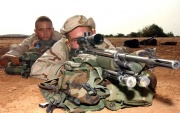
The 1st Battalion of the 3rd United States Infantry Regiment (The Old Guard) in the Military District of Washington is the sole remaining regular United States Army combat field unit where the M14 is still issued as the standard rifle, along with a chromed bayonet and an extra wooden stock with white sling for military funerals, parades, and other ceremonies. The United States Air Force Honor Guard uses a version of the M14 specially modified by the USAF Gunsmith that prevents semi-automatic fire; members have to manually cycle a new round by pulling on the charging handle every time they fire. The United States Navy Ceremonial Guard and Base Honor Guards also use the M14 for 3-volley salutes in military funerals. It is also the drill and parade rifle of the United States Military Academy, United States Naval Academy, United States Air Force Academy, The Citadel, Norwich University, Virginia Military Institute, and North Georgia College and State University.
Various Special Operations Forces (SOF) still use M14 variants, notably the Navy SEALs, who have used the M14 as an infantry, marksman, and sniper rifle. At the outbreak of the Vietnam War, SEALs used modified M14 as sniping rifles.[3] Various sniper variants have been used by the SEALs, often mistaken with M21 in the overt literature, only one of them has received a standard name in the U.S. military designations system: the XM25, developed by the Special Forces. These sniper variants have probably been replaced by the Mk 11 Mod 0, selected in 2000. SEALs also use the Mk 14 Mod 0 EBR (Enhanced Battle Rifle) for close-quarters battle and in a designated marksman role.
U.S. Navy ships carry several M14s in their armories. They are issued to Sailors going on watch out on deck in port. The M14 is also used to shoot a large rubber projectile to another ship when underway to start the lines over for alongside refueling and replenishment.
Although a very secretive unit, the "Delta Force" is known to have used M14 sniper variants. According to Black Hawk Down: A Story of Modern War, the well-known account of the Battle of Mogadishu, at least one of the "D-Boys", Sergeant First Class Randy Shughart, used an M14 for sniping from helicopters to provide support fire to ground troops. His M14 was probably fitted with an Aimpoint 3000 sight.
The Special Forces ("Green Berets") have made some use of the XM25 "spotter rifle". The XM25 was developed in the late 1980s within the 10th Special Forces Group, which was charged to support Special Forces sniper weapons as well as the Special Operations Target Interdiction Course (SOTIC). The XM25 was first planned as a replacement for the old M21, but after the Army adoption of the M24 SWS as its standard sniper rifle, the M25 was intended to be used by spotters of the sniper teams, while the snipers would use the bolt-action M24. Tests had shown that the M24 and M25 have the same precision when using the same M118 ammunition.
Though the M14 has remained in service longer than any U.S. infantry rifle with the exception of the Springfield M1903 rifle, it also holds the dubious distinction of serving as the standard infantry rifle of the U.S. Army for a shorter span of time than any other weapon.
[edit] Commercial and non-U.S. use
The commercial, semi-automatic-only version available to the general public is sold by Springfield Armory, Inc. of Geneseo, IL and other manufacturers as the M1A, M14S, and other model names.
M14 production tooling was sold in 1967 to the Taiwanese, who in 1968 began producing their Type 57 Rifle. The State Arsenal of the Republic of China produced over 1 million of these rifles from 1969 to the present. The People's Republic of China produced semi-automatic copies of the M1A under the model numbers of M305 and M14S. These rifles have forged receivers (as opposed to Springfield's investment cast receivers), but have non-standard metric dimensions on some parts such as the muzzle threads and magazine release pins.
The Philippine government issues M14 rifles, together with M1 carbines, M1 Garands and M16s, to their civilian defense forces, including the Civilian Auxiliary Forces Geographical Unit (CAFGU) and Civilian Volunteer Organization (CVO). The Greek Navy is also a user of M14.
[edit] Production
Standard service rifles were produced from 1959 to 1964.- Springfield Armory, Springfield, MA
- Harrington & Richardson Arms Co., Worcester, MA
- Olin Mathieson Chemical Corp. (Winchester-Western Div.), New Haven, CT
- Thompson-Ramo-Wooldridge Inc.(TRW), Cleveland, OH (considered the highest-quality variant, TRW marked parts often command a premium when they come up for sale)
The purpose-built National Match version was produced in 1962 and 1963 by Springfield Armory, and in 1964 by TRW. Springfield Armory upgraded a number of service-grade rifles in 1965 and 1966 to National Match specifications. Upgrading was also carried out in 1967 at the Rock Island Arsenal. These M14 variants are to this day capable of extreme long-range accuracy.
Springfield and TRW delivered more than 11,000 National Match rifles in the 1962–1964 period. Roughly 8,000 service rifles were modified to NM standards during 1965–1967.
The US military currently fields M14s produced by Smith Enterprise in SDM roles.[1]
[edit]
[edit] Military
[edit] M15
- Main article: M15 rifle
- Selective fire, heavy barrel version of the standard M14, intended to replace the BAR as a squad automatic weapon.
- Never issued. The M15 was declared obsolete prior to entering production.
[edit] M14E1
- The M14E1 was tested with a variety of folding stocks to provide better maneuverability and the like for armored infantry, paratroopers and others.
- No variant was standardized.
[edit] M14E2/M14A1
- Selective fire version of the standard M14 used as a squad automatic weapon.
- Successor to the short-lived M15 rifle. The developmental model was known as the M14E2.
- First designated as M14E2 when it was issued in 1963 and redesignated as M14A1 in 1966.
[edit] M14 SMUD
- Stand-off Munition Disruption, used by Explosive Ordnance Disposal personnel to destroy unexploded ordnance.
- Essentially an M14 National Match rifle with scope.
[edit] Mk 14 Mod 0 EBR
- Main article: United States Navy Mark 14 Mod 0 Enhanced Battle Rifle
- Shorter, more tactical version of the M14, with a retractable stock and multiple rails for more accessories.
[edit] DMR
- Main article: U.S. Marine Corps Designated Marksman Rifle
- Modified designated marksman version of the M14, used by the USMC.
[edit] Commercial
[edit] M14K
- Variant designed by La France Specialties of San Diego, California, and produced by Smith Enterprise of Tempe, Arizona.
- The prototype actually used the M60 machine gun parts for the gas system; however, production models had the system custom-manufactured so the rate of fire could be controlled.
[edit] Types of sights
- Rear peep, front blade, metric
- Rear National Match peep with hood, front National Match blade, metric
[edit] Rifle design
[edit] Receiver markings
Stamped into receiver heel:
- U.S. Rifle
- 7.62-MM M14
- Springfield Armory (or commercial contractor name)
- Serial number
[edit] Stock
The M14 rifle was first furnished with a walnut stock, then with birch and finally with a synthetic stock. Original equipment walnut and birch stocks carry the Department of Defense acceptance stamp or cartouche (an arc of three stars above a spread-winged eagle). These stocks also carried a proof stamp, a P within a circle, applied after successful test-firing.
Rifles manufactured through late 1960 were provided with walnut handguards. Thereafter synthetic, slotted (ventilated) hand guards were furnished but proved too fragile for military use. These were replaced by the solid synthetic part still in use, usually in dark brown, black or a camouflage pattern.
[edit] Rifling
Right-hand twist, 1:12 inches, 4 grooves
[edit] Accessories
Although M14 rifle production ended in 1964, the limited standard status of the weapon resulted in the continued manufacture of accessories and spare parts into the late 1960s and beyond.
- M6 bayonet with M8A1 sheath
- M2 Bandolier
- Sling [one-piece cotton or nylon webbing or M1907 (two-piece leather)]
- Cleaning kit (butt-trap) included a combination tool, ratchet chamber brush, plastic lubricant case, brass bore brush, four cleaning rod sections, cleaning rod case, and a cleaning rod patch-holding tip.
- M5 winter trigger and winter safety
- M12 blank firing attachment and M3 breech shield
- Cartridge clip (five cartridges) and magazine filler for charging magazines
- M1961 ammunition magazine pouch
- M2 bipod
- M76 grenade launcher
- M15 grenade launcher sight
- Mk 87 Mod 0/1 line (rope) throwing kit
[edit] See also
- List of firearms
- M1 Garand rifle
- M1A rifle
- M21
- M25
- U.S. Marine Corps Designated Marksman Rifle
- Mini-14
- SOCOM 16
[edit] Resources
| Gun Owners' Resource has the following relevant documents available for free download for the M14 rifle and/or its variants: |
- Springfield M1A Owner's Manual - civilian variant (.pdf file)
- US M1A, M14 Accurization US Army Marksmanship Unit (.pdf file)
- M14 AND M14A1 RIFLES AND RIFLE MARKSMANSHIP - document FM 23-8, Headquarters, Department of the Army, Washington DC, 16 March 1987. Approved for public release. (26MB .PDF file, 253pgs)
The following images are also available for reference:
[edit] References
- Duff, Scott A, Miller, John M and contributing editor Clark, David C. The M14 Owner's Guide and Match Conditioning Instructions. Scott A. Duff Publications, 1996. ISBN 1-888722-07-X
- Stevens, R. Blake. U.S. Rifle M14 — from John Garand to the M21. Collector Grade Publications, Inc., 1995. ISBN 0-88935-110-4
- Murphy, Edward F. The Hill Fights: The First Battle of Khe Sanh. New York: Presidio Press, 2003. ISBN 0-7393-1834-9
- Pisor, Robert L. The End of the Line: The Siege of Khe Sanh. New York: W.W. Norton & Company, Inc., 2002. ISBN 0-393-32269-6
- FM 23-8 U.S. Rifle 7.62mm, M14 and M14E2 May 1965
- FM 23-8 U.S. Rifle 7.62mm, M14 December 1959
[edit] External links
- New-era M14 alleviates reliability issues
- Modern Firearms Site
- The M14/M1A Magazine FAQ
- Different's M1A Site
- M14 Firing Line Forum
- U.S. Rifle, cal. 7.62mm, M14
- 7.62 NATO Battle Rifles
[edit] Video links
| [show] |
|---|

